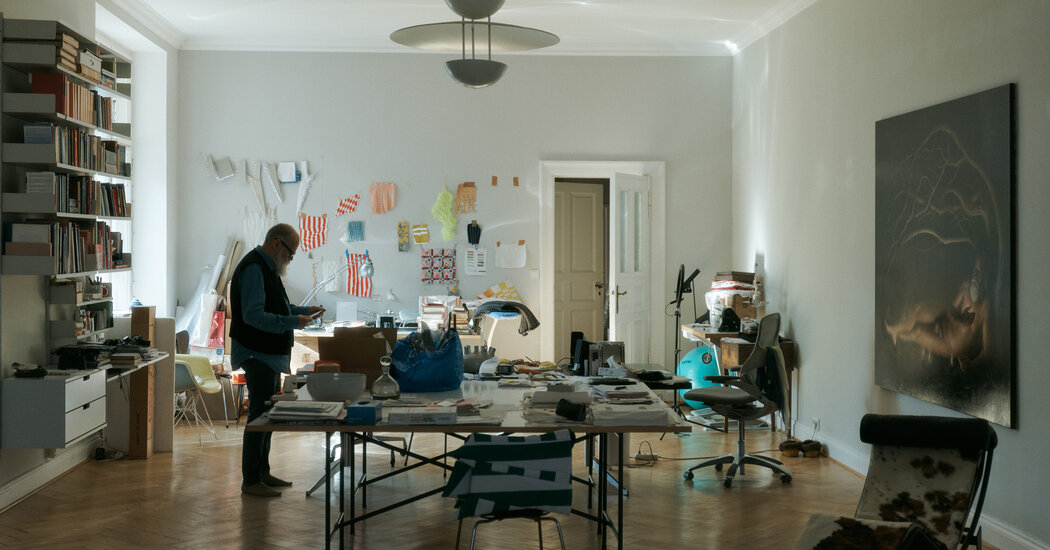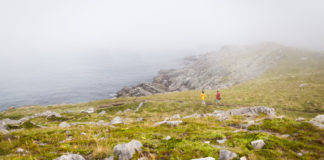
“I’m finding it difficult to be 76 and busy,” says the artist AA Bronson from his Berlin studio, where he also lives. “The two don’t really go together.” Though he’s not currently focused on producing new works, Bronson, who has devoted his career to pushing against negative queer representation through the production of confrontational, easily reproducible art, has been spending much of his time planning international exhibitions of his unapologetically political oeuvre. General Idea, the collective he formed with his late life partners Felix Partz and Jorge Zontal — together, the three Canadians were responsible for some of the most striking AIDS-related compositions of the late 1980s and the 1990s — is currently the subject of its biggest retrospective to date, at the National Gallery of Canada in Ottawa. Bringing together the group’s zines, multimedia installations and performances, the show will travel to Amsterdam’s Stedelijk Museum early next year before moving to the Gropius Bau exhibition hall in Berlin, where Bronson has lived with his husband, the architect Mark Jan Krayenhoff van de Leur, since 2013. (Bronson recently traveled to New York for the NY Art Book Fair, which he founded in 2009 during his time as executive director of the Printed Matter bookstore and artist space, and to visit the Drawing Center, in SoHo, which is displaying a selection of General Idea’s lesser-known illustrations, of colorful masks and genitals on diary pages and sketchbooks, through Jan. 15.)
Despite his busy schedule, Bronson, in round glasses with his signature white beard draped over a black vest, is distracted by more pressing matters: The apartment he’s been renting in Berlin’s Charlottenburg neighborhood for the past nine years has become a source of unrest. Bronson is convinced that the building’s new owner wants his tenants out so he can renovate the property and flip it for profit. One of his tactics, or so the artist has surmised, was starting a flood on the unit above him that temporarily forced him to evacuate. “We have a landlord who seems particularly focused on getting his own way, and he’s tried various techniques to get us to leave,” Bronson says. “So far, we’re still here.”
The apartment is made up of three main rooms — all simply decorated and painted white. Bronson and his assistants work mainly on a tidy desk in the largest one, where there are no signs of the recent deluge. Walking around the space, gesturing with one hand and grasping the laptop on which the call is taking place in the other, he breezes through the artworks he’s put back on display: one of General Idea’s AIDS paintings; one of his “Plaid” collaborations with the American artist Keith Boadwee; one of his white-gesso-covered American flag works; and a portrait by the New York-based painter TM Davy of Bronson lying naked under a tree in the Meat Rack, a stretch of wooded dunes on Fire Island where men go cruising and where he’s collaborated on site-specific performances. Bronson stops to point behind a neatly organized bookcase. “That’s where the ceiling opened up,” he says. “There was water gushing right over that light bulb. It felt so dangerous, and certainly dramatic.” Below, Bronson answer T’s Artist’s Questionnaire.
What is your day like? How much do you sleep, and what’s your work schedule?
I usually sleep six or seven hours at night, then another hour or two in the afternoon. I would never have even dreamed about sleeping during the day until quite recently, well into my 70s. I’ve always seemed to exist on relatively little sleep, and it’s never been a problem. I usually have my nap between 6 and 8 p.m., with my bedtime being around 1 in the morning. I kind of work whenever I feel like it. Especially now that so much work is on the computer or involves communication, one must be ready and available at any moment.
How many hours of creative work do you think you do in a day?
The actual making of art comes once all the nuts and bolts are out of the way. Part of being 76 is that I’ve got a lifetime of work in storage; both myself and General Idea were very prolific. No matter how much I sell, there’s still tons of stuff in storage, so I spend an awful lot of my time organizing exhibitions rather than producing [art for] them. When I do produce, it tends to be all at once — a body of work can appear in a month. I’m not the kind of person who’s sitting at the easel day after day.
What’s the first piece of art you ever made?
When I was 3, I announced to my mother that I was going to be an artist when I grew up. I was always drawing back then, but I don’t remember the first piece from that period. In university, I was doing visual publications. I produced an eight-page visual insert once a month for the newspaper, and that was in like 1964 or ’65, in an era when underground newspapers were just appearing. Starting in ’72, General Idea produced File magazine, and that became one of the main things we were known for.
What’s the worst studio you’ve ever had?
I suppose the worst one was in New York, on the corner of 14th Street and Ninth Avenue — where an Apple store is now. General Idea was on the second floor of that building, and it was quite cheap in the late ’80s, but none of the windows could close properly and there were huge lineups of trucks zooming down that road and belching out smoke — which would come in through our window. It got full sun most of the day because all the windows faced west, so it was basically impossible to use in the summer because it was so hot. And because the windows didn’t close in the winter, it was also incredibly cold.
What’s the first work you ever sold? For how much?
It was a piece called “Evidence of Body Binding” (1971). I think it probably sold for around 10,000 Canadian dollars, half of which, of course, went to the dealer, and there were three of us. … We were shocked, frankly, when it sold to the National Gallery of Canada. At that time, [the institution] had a reputation for buying things the same year they were made. But still, it shocked us because I think it was only our second show and this very large piece sold at the opening.
When you start a new piece, where do you begin?
I have no idea. Things tend to come out of other things — old projects turn into new projects. It’s rather difficult to tell when something begins, because it doesn’t really have a beginning or an ending.
How do you know when you’re done?
Probably I don’t. I’m not as good at self-editing as I should be, but that can be said by almost any artist, I think. It used to be, with Felix and Jorge and I, that Felix was the editor and would say, “No more, stop.” When he and Jorge died in ’94, I no longer had an editor, so I’ve had to kind of figure that out for myself.
How many assistants do you have?
There’s Sheldon, who’s sitting next to me, as my main assistant, and he works all those [Wednesday through Friday] hours, and there are two other people who work in a more fragmentary kind of way, depending on what’s needed.
Have you assisted other artists before? If so, who?
After ’94, most of the work I’ve done has been in collaboration with other artists, many of them younger. I’ve done a lot of collaborations. One of the most recent was with Keith Boadwee on a piece called “Plaid” (2015). If you do a search on Keith, you might see photos of Keith and I naked. That was a very fruitful collaboration.
What music do you play when you’re making art?
I usually like to have silence. If I do play music, it might be a bit of Tibetan throat chanting or something. My husband, Mark, likes to play music and he plays it quite a lot. And in the old days, Felix and Jorge loved to play music. Maybe because we lived as a group for 25 years, I kind of let the music part of me slide into the background. The thing about being a group, I never realized until they died, is that there’s one person who reads the movie reviews and recommends what films we should be seeing, somebody else doing the music, and somebody else doing the cooking. The life of the group gets split up without you even being conscious of it, but that’s the way it is. After they both died, I suddenly realized there were all sorts of things that I just hadn’t done for decades, and suddenly had to do by myself.
When did you first feel comfortable saying you’re a professional artist?
When I was 3. I announced that I was an artist, or was going to be an artist, and was very self-assured about it. I became nervous about it in high school because I felt that it was too selfish to be an artist. It was an era when we were all going to try to do good in the world, so I went to university to study architecture. But I only lasted two years, became a dropout and then became an artist.
Is there a meal you eat on repeat when you’re working?
In the days of General Idea, Jorge did all the cooking. He was a Serbian Jewish refugee who grew up in Caracas, so he had this very hybrid Eastern European-slash-South American approach to cooking. He made a lot of stews, let’s call them.
How often do you talk to other artists?
Everybody I know, pretty much, is an artist. That’s kind of weird, isn’t it?
What’s the last thing that made you cry?
I tear up easily, but I don’t cry easily. Deaths get to me, and when I do cry, it tends to be totally unexpected, like something I wouldn’t imagine I’d cry about, and often it’s something happening to somebody else, not to me.
What do you usually wear when you work?
I often wear things I shouldn’t and then get splashes all over them. I’m not a painter, per se, so often, when I’m working, I’m just sitting at the computer in a black T-shirt, jeans and bare feet.
What do you pay for rent?
We have just under 3,000 square feet. Before utilities, I think we’re paying €3,800 [about $3,800] a month, which is less than we were paying in New York for 700 square feet.
What do you buy with the most frequency?
Water, to tell you the truth — bottled water. I hate Berlin water. It’s not full of chemicals; it’s just not tasty.
What’s your worst habit?
I pick my nose.
What embarrasses you?
When something embarrasses me, I’m very good at not letting on that it embarrasses me. And it’s true that very little embarrasses me, and that I tend to say what I think when I really shouldn’t. I never learned proper manners that way.
Do you exercise?
I do not exercise at all. I walk.
What are you reading?
I’ve recently taken to reading American murder mysteries, like [those by] Raymond Chandler or Dashiell Hammett. I went through a period like that in the early ’80s, and I seem to be repeating myself. These days I just go to a corner and read Raymond Chandler. I guess that’s my procrastination, because I’m reading the forewords to all his books.








